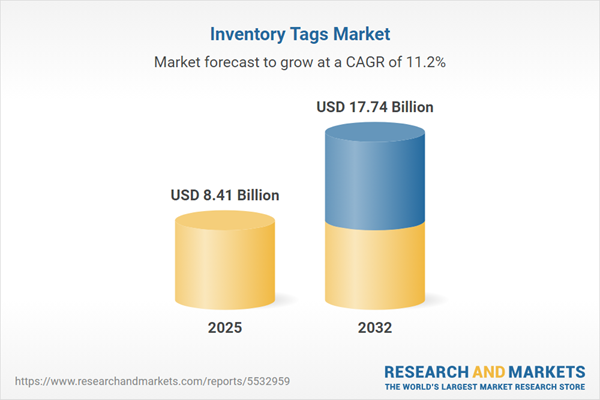Speak directly to the analyst to clarify any post sales queries you may have.
Inventory tags are fast becoming a cornerstone of modern supply chain management, as organizations prioritize operational resilience and compliance amid growing complexity. For senior leaders, implementing advanced inventory tagging solutions underpins risk management, supports digital transformation objectives, and enables streamlined adaptation within dynamic global markets.
Inventory Tags Market Snapshot
The global inventory tags market reached USD 7.56 billion in 2024 and is projected to increase to USD 8.41 billion by 2025, with steady momentum anticipated through 2032. This expansion is driven by rapid digitalization, broad adoption of automated asset tracking, and increased investments in advanced supply chain technologies. Industries including retail, logistics, and manufacturing are emerging as key drivers, as inventory tags boost efficiency, traceability, and regulatory alignment. Enterprises deploying inventory tagging solutions are better equipped to navigate shifting markets and regulatory environments, building adaptable foundations for ongoing innovation.
Scope & Segmentation: Inventory Tags Market
This report provides senior decision-makers with comprehensive insight into the primary segments and challenges currently shaping the inventory tags market:
- Tag Types: Barcode tags serve as a fundamental tool for managing sizable asset inventories. Data Matrix and QR code tags support consistent scanning and quick traceability data access. RFID tags—including active and passive formats—deliver real-time asset tracking and heightened security. Smart tags leveraging Bluetooth, NFC, or Wi-Fi directly link inventory visibility to warehouse and logistics automation.
- Material Types: Metal tags, such as aluminum and stainless steel, thrive in demanding or hazardous settings, offering durability over extended use. Flexible plastics, including polyester, vinyl, and Tyvek, are recognized for chemical resistance and align with sustainable asset management strategies.
- Geographies: The Americas are enhancing efficiency with process automation and integrated data systems, notably in retail and logistics. EMEA is contending with complex, multi-jurisdictional regulatory demands, fueling adoption of standardized tagging to ensure compliance. Asia-Pacific invests heavily in digital infrastructure, reinforcing both competitiveness and coordination across vast manufacturing and distribution networks.
- Covered Companies: Major market providers—Avery Dennison Corporation, Zebra Technologies Corporation, Impinj, NXP Semiconductors, Checkpoint Systems, Alien Technology, Nedap, Confidex, Identiv, and Omni-ID—drive progress by integrating digital features and establishing high standards for quality and reliability.
Inventory Tags: Strategic Key Takeaways
- Integration of IoT-enabled inventory tags significantly enhances end-to-end supply chain visibility and transparency, supporting more proactive risk mitigation and compliance assurance.
- Barcode systems offer robust oversight for routine asset management, while RFID and smart tags enable advanced traceability and greater efficiency where automation is paramount.
- Innovations in durable metals and sustainable plastics present organizations with reliable, long-lasting tag options that also support lifecycle cost reduction initiatives.
- Implementing solutions in line with evolving regional regulations preserves operational continuity and limits compliance risk exposure.
- Diversifying supplier relationships strengthens resilience, promoting adaptive supply chains that can weather regulatory or external market fluctuations.
- Collaborating closely with established technology partners expedites the digital transformation process, preparing organizations to pivot rapidly amid new regulatory or market conditions.
Tariff Impact: Navigating Policy Shifts
Recent U.S. tariff changes have raised input costs for critical inventory tag components such as semiconductors and specialty inks. Organizations are responding by expanding supplier networks, increasing nearshoring activity, and initiating rigorous scenario planning to secure procurement amid ongoing trade developments. These strategies help maintain uninterrupted inventory tag availability and stability in the face of shifting regulations.
Methodology & Data Sources
This market analysis is based on extensive industry research, regulatory assessments, patent reviews, and expert interviews. All findings are validated through evidence-based triangulation to ensure that guidance is accurate and actionable for executives and procurement leaders in the inventory tags sector.
Why This Inventory Tags Market Report Matters
- Empowers leaders to align inventory tagging investments with evolving requirements and broad organizational objectives across global supply chains.
- Supports executive decision-making by offering insights into technology adoption, process optimization, and the implementation of compliance or sustainability initiatives.
- Equips organizations with strategies for managing complex regulatory and technological shifts essential to successful inventory tagging worldwide.
Conclusion
Inventory tags establish a reliable platform for supply chain visibility and organizational agility. Senior decision-makers receive actionable recommendations to deploy resilient inventory tagging strategies aligned with today’s evolving operational demands.
Additional Product Information:
- Purchase of this report includes 1 year online access with quarterly updates.
- This report can be updated on request. Please contact our Customer Experience team using the Ask a Question widget on our website.
Table of Contents
3. Executive Summary
4. Market Overview
7. Cumulative Impact of Artificial Intelligence 2025
List of Figures
Companies Mentioned
The companies profiled in this Inventory Tags market report include:- Avery Dennison Corporation
- Zebra Technologies Corporation
- Impinj, Inc.
- NXP Semiconductors N.V.
- Checkpoint Systems, Inc.
- Alien Technology, Inc.
- Nedap N.V.
- Confidex Ltd.
- Identiv, Inc.
- Omni-ID Ltd.
Table Information
| Report Attribute | Details |
|---|---|
| No. of Pages | 196 |
| Published | November 2025 |
| Forecast Period | 2025 - 2032 |
| Estimated Market Value ( USD | $ 8.41 Billion |
| Forecasted Market Value ( USD | $ 17.74 Billion |
| Compound Annual Growth Rate | 11.2% |
| Regions Covered | Global |
| No. of Companies Mentioned | 11 |








